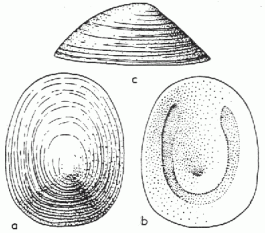
height 1.2 cm; diameter 3 cm
Carboniferous (Viséan of Western Euramerica (Indiana)
| Gastropoda | ||
| Mollusca | Patellogastropoda |
Gastropoda
└─► |
|||
None |
|
Abbreviated Dendrogram
Mollusca
├─Aculifera
└─Conchifera
╘═Helcionelloida
└─┬─Bellerophontoidea
└─Gastropoda (crown group)
╞═Eogastropoda (paraphyletic or polyphyletic)
│ ├?─Macluritoidea
│ ├?─Euomphaloidea
│ └─Patellogastropoda
└─Orthogastropoda
├─Vetigastropoda
├─Neritimorpha
└─┬─Caenogastropoda
└─Heterobranchia
├─Opisthobranchia
└─Pulmonata
|
Contents
Index |
Taxa on This Page
The true limpets (Patellogastropoda) are a familiar site to beachcombers and visitors to the seashore, clinging tenaciously to rocks in the intertidal zone in countless numbers, or in shallow rock pools. The shell is a simple cap shape, of which there is no sign of coiling even in the protoconch, and there is a reduction or even loss of gills among the various lineages. The mantle and shell overhang produce a distinct groove on each side between the foot and the mantle edge. Barnes (1980).
Patellogastropoda seem to have evolved from Euomphalids, possibly as part of the general movement of life colonizing the littoral niche. Like the chitons, they are a primitive molluscan type that found refuge from predators in the harsh intertidal environment. If one includes the Metoptomatidae, then the group first appeared in the Middle Ordovician Knight, et al., 1960), otherwise the Patellogastropoda date back no further than the Middle Triassic, which is when several extant families seem to appear. The term "true limpets" is used here to distinguish these gastropods from several other unrelated lineages which also developed a limpet-shell morphology.

|
Lepetopsis levettei (White 1882)
height 1.2 cm; diameter 3 cm Carboniferous (Viséan of Western Euramerica (Indiana) image © xxxx Knight, et al., 1960 p.I232
|
Metoptomatidae:
Stratigraphic Range: Middle Ordovician (Darriwilian) to Middle Permian Knight, et al., 1960)
Phylogeny: Euomphaloidea? ::: Metoptomatidae :::??? Patellogastropoda
Characteristics: shell limpet-shaped or weakly endogastrically curved; horseshoe-shaped muscle scar with anterior opening not closed by pallial line, nature of inner shell layers and possibly coiled protoconch imperfectly known. Knight, et al., (1960).
Taxon Rank: Family. Knight, et al., (1960)
Notes: Golikov & Tarobogatov (1975) place the Metoptomatidae among the Helcionellida on the basis of conchological similarity. If so, this means that the Metoptomatids are the last surviving Helcionelloids, and not gastropods at all. However the single Metoptomatid muscle-scar is nothing like the multiple Trybliidid-like muscle scars known from the supposed Helcionellid Scenella. Knight, et al., 1960 tentatively include the Metoptomatidae among the Patellina, and Jeffery 2001) follows suit. There is a gap of several tens of millions of years between the Middle Permian when the last Metoptomatids lived, and the Middle Triassic when the true limpets appear. If the Metoptomatidae are Patellogastropod ancestors then this is a paraphyletic group that would seem to have given rise to later forms at the end of Permian. It is just as likely however that this is a distantly related, or completely unrelated, taxon
Stratigraphic Range: Middle Triassic to Recent
Euomphaloidea (or Metoptomatidae?) ::: + ?Cocculiniformia + Patellogastropoda : + Lepetopsina + Patellina + Nacellina
Characteristics: $ lowest number of chromosomes (9 pairs) ; $ pallial gills, $ "wart-organ," $ rectum outside of pericardium, $ loss of gonoducts, style and gastric shield Lindberg, 1988); $ Salivary glands compact with ducts; $ loss of right clenidium; $ hypobranchial glands reduced; $ osphradium of distinct type close to the "wart-organ"; (all from Haszprunar, 1988], note: Some or all of these characters may also pertain to Eogastropoda as a whole; predominantly intertidal and shallow nearshore habitats, global, cap-shaped shell Lindberg, 1988).
According to Sasaki (1998), the Patellogastropoda are characterized (including plesiomorphic primitive characters) by:
1) anteriorly pointed shell apex, 2) symmetrical protoconch, 3) shallow pallial cavity restricted to head region, 4) operculum absent in post-larval stage, 5) horseshoe-shaped shell muscle that is constricted into bundles and connected anteriorly by pallial muscle, 6) shell muscle penetrated by blood vessels from visceral sinus, 7) retractile pallial tentacles, 8) eyes within cephalic tentacles, 9) open eyes without vitreous body, 10) symmetrically paired osphradia of "wart-organ" type on pallial floor (absent in Lepetidae, Acmaeidae, and Neolepetopsidae), 11) ctenidium post-torsional left only (in Acmaeoi-dea), 12) ctenidium (if present) lacking skeletal rods, 13) hypobranchial gland absent, 14) secondary circumpallial gills (in Patelloidea and some lottiids), 15) single bilamellate, double-layered jaw, 16) anterior wings of jaw associated with inner lips, 17) posterior wings of jaw bound to odontophore, 18) licker well developed, 19) dorsal protractor muscles of odontophore present, 20) ventral approximator muscle of odon tophore cartilages two-layered, 21) transverse labial muscles present, 22) docoglossate (= stereoglossate) radula that is longitudinally inflexible on bending plane, 23) greatly reduced or completely lost central tooth, 24) lateral teeth with broad bases firmly fixed on basal plates (except Lepetidae and Neolepetopsidae), 25) mid-esophagus with lamellar folds, 26) simplification of stomach (loss of gastric shield and gastric caecum; reduction of sorting area), 27) single auricle, 28) rectum not passing through pericardium or ventricle, 29) muscular bulbous aorta within pericardium, 30) two unequal kidneys (smaller left and much larger right), 31) gonoduct extending from left side and connected to right kidney, 32) labial ganglia inter connected by labial commissure, and 33) statocysts on outer sides of pedal ganglia.
Taxon Rank: Order Lindberg, 1988).
Links: Limpets (Marine Ecology Online Habitat Series); Molluscs - Limpets (Australian Seashores); Limpets (Australian Museum);
Lepetopsina:
Stratigraphic Range: no fossil record known
Phylogeny: Patellogastropoda : Metoptomatidae + Lepetopsina + Patellina + Nacellina
Taxon Rank: Suborder (Lindberg, 1988).
Characteristics: Deep-water forms
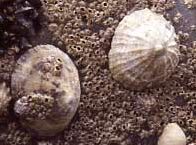
|
Patella vulgata
from Southwick beach, Sussex © Andy Horton (photographer) and the British Marine Life Study Society [cropped from original image]
|
Patellina:
Stratigraphic Range: ? Jurassic or Early Cretaceous II (Albian) to Recent (Lindberg, 1988).
Phylogeny: Patellogastropoda : Lepetopsina + Patellina + Nacellina
Characteristics: $ Concentric and radial foliated shell structure; $ loss of prismatic outer layer, predominantly intertidal, tropical-temperate seas.
Taxon Rank: Suborder (Lindberg, 1988).
Contains: family Patelliidae
Notes: These limpets strikingly parallel the chitons, which are also adapted for life on rocky shores. In Patella, a widespread intertidal genus, secondary gills have formed as folds of the mantle, and project into the pallial groove along the side of the body. The ventilating current enters and leaves laterally in the vicinity of each gill. Barnes (1980).
Like chitons with which they share a very similar lifestyle, these shy animals move about slowly at night, grazing on algae and other microorganisms encrusting the rock surface
Links The Patella Site - all about the family Patellidae
|
||
Scurriopsis neumayri Gemmellard 1879
height 1.5 or 2 cm; diameter about 2 or 3 cm Lower Lias (Early Jurassic (Hettangian/Sinemurian)) of European Laurasia (Sicily) image © xxxx Knight, et al., 1960 p.I233
|
Nacellina:
Stratigraphic Range: Middle Triassic to Recent Knight, et al., 1960).
Phylogeny: Patellogastropoda : Lepetopsina + Patellina + Nacellina : Nacelloidea + Acmacoidea
Characteristics: $ Reduced terminal chromosome, $ reduction of inner radular tooth field, invasion of polar regions and deep sea.
[Lindberg, 1988 p.38]
Taxon Rank: Suborder [Lindberg, 1988]
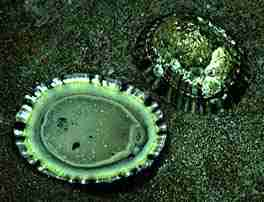 |
Cellana tramoserica (Holten, 1802)
length up to 5 or 6 cm South-East Australia image © Keith Davey Life on Australian Seashores
|
Nacelloidea:
Stratigraphic Range: Eocene to Recent [Knight, et al., 1960 p. I235]
Nacellina : Acmacoidea +
Characteristics: $ Reduction of crossed-lamellar layers.
Nacellidae : Loss of concentric crossed-lamellar layer.
[Lindberg, 1988 p.38]
Taxon Rank: Superfamily and Family
Notes: Twelve species of Nacella are known; they are Antarctic or subantarctic in distribution and live attached to large seaweed. Thirty species of Cellana are found on intertidal rocks in the indo-Pacific. Some species brood their young, which upon hatching simply crawl away [Rosenberg 1992 p.30].
Acmacoidea:
Stratigraphic Range: Middle Triassic to Recent [Knight, et al., 1960 p. I233]
Nacellina : Nacelloidea + : Lepetidae + Acmaeidae + Lottiidae
Characteristics: $ 10 pairs of chromosomes, $ nuchal cavity gill, $ loss of pallial gill $ 1 pair marginal teeth.
[Lindberg 1988 p.38]
Taxon Rank: Superfamily [Lindberg 1988]
Lepetidae:
Stratigraphic Range: Miocene to Recent [Knight, et al., 1960 p. I235]
Acmacoidea : Acmaeidae + Lottiidae +
Characteristics: $ Fusion of lateral teeth, $ loss of nuchal cavity gill, $ loss of osphradial ganglia.
[Lindberg 1988 p.38]
Taxon Rank: Family [Lindberg 1988]
Notes: These animals, which live in polar and deep water with some living as deep as 3400 meters. There are seven genera altogether. [Rosenberg 1992 p.29]. A typical form, Lepeta, lack gills, and gas exchange occurs across the general mantle surface. [Barnes 1980 p.331]
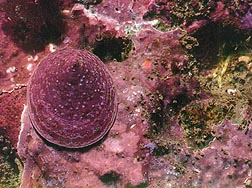
|
Acmea mitra Rathke, 1833
length 3 cm Aleutian Islands to Baja California from Marine Ecology Online Habitat Series - Limpet Relatives The pink color is from algae on which the animal feeds image © xxxx by Gotshall, D.W. 1994. Guide to Marine Invertebrates Alaska to Baja California. Sea Challengers, Monterey, CA
|
Acmaeidae:
Stratigraphic Range: ?Triassic to Recent [Knight, et al., 1960 p. I233, but most of these actually belong under the Lottiidae]
Acmacoidea : Lepetidae + Lottiidae +
Characteristics: $ Simplified basal plates, $ V-ed radular rows, $ loss marginal teeth, temperate and deep water.
[Lindberg 1988 p.38]
Taxon Rank: Family [Lindberg 1988]
Notes: Most species previously placed in this family have since been transferred to the Lottiidae. Only ten species remain placed here, most of which go under the genus Pectinodonta, a genus of small deep-sea blind forms. The only other species is Acmaea mitra [Rosenberg 1992 p.29]
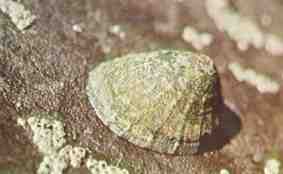 |
|
image © xxxx from Maclachlan, D., and Ayers, J. 1979. Sea Creatures. Naturegraph, CA.
|
Lottiidae:
Stratigraphic Range: Middle Triassic to Recent [Knight, et al., 1960 p. I233]; Lottia: Late Pliocene to Recent [Lindberg 1988 p.45]
Acmacoidea : Lepetidae + Acmaeidae +
Characteristics: $ Loss of foliated shell structure.
[Lindberg 1988 p.38]
Taxon Rank: Family [Lindberg 1988]
Notes: There are about 100 extant species, which range from 12 mm to 10 cm in size, and in shape from flattened to deep. Most live intertidally, although some live on sea grasses. The family has worldwide distribution, although the greatest diversity is on the west coast of North America. Rosenberg 1992. These animals possess only the left gill, which extends to the right side of the body. The inhalant current enters the mantle on the left side, some of the current flows in the left lateral mantle groove; the rest over the gill and then down the right mantle groove, before the two exhalant streams converge and exit posteriorly. [Barnes 1980 p.331]
page uploaded 6 March 2003
checked ATW040305
original material Creative Commons Attribution M. Alan Kazlev
this material may be freely used
all other material © original authors or sources